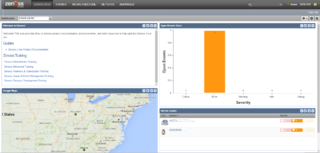
Cacti is an open-source, web-based network monitoring, performance, fault and configuration management framework designed as a front-end application for the open-source, industry-standard data logging tool RRDtool. Cacti allows a user to poll services at predetermined intervals and graph the resulting data. Through the use of Cacti plugins, it has been extended to encompass all of the FCAPS operational management categories. It is generally used to graph time-series data of metrics such as CPU load and network bandwidth utilization. A common usage is to monitor network traffic by polling a network switch or router interface via Simple Network Management Protocol (SNMP).

CUPS is a modular printing system for Unix-like computer operating systems which allows a computer to act as a print server. A computer running CUPS is a host that can accept print jobs from client computers, process them, and send them to the appropriate printer.
Nagios is an event monitoring system. Nagios offers monitoring and alerting services for servers, switches, applications and services. It alerts users when things go wrong and alerts them a second time when the problem has been resolved.

The Multi Router Traffic Grapher (MRTG) is free software for monitoring and measuring the traffic load on network links. It allows the user to see traffic load on a network over time in graphical form.

OSSIM (Open Source Security Information Management) is an open source security information and event management system, integrating a selection of tools designed to aid network administrators in computer security, intrusion detection and prevention.

The company Zenoss, Inc. was founded in 2005 and is headquartered in Austin, Texas. The company develops hybrid IT monitoring and analytics software.

Pandora FMS is software for monitoring computer networks. Pandora FMS allows monitoring in a visual way the status and performance of several parameters from different operating systems, servers, applications and hardware systems such as firewalls, proxies, databases, web servers or routers.
OpenNMS is a free and open-source enterprise grade network monitoring and network management platform. It is developed and supported by a community of users and developers and by the OpenNMS Group, offering commercial services, training and support.
The following tables compare general and technical information for a number of notable network monitoring systems. Please see the individual products' articles for further information.

collectd is a Unix daemon that collects, transfers and stores performance data of computers and network equipment. The acquired data is meant to help system administrators maintain an overview over available resources to detect existing or looming bottlenecks.

TACTIC is a web-based, open source workflow platform and digital asset management system supported by Southpaw Technology in Toronto, ON. Designed to optimize busy production environments with high volumes of content traffic, TACTIC applies business or workflow logic to combined database and file system management. Using elements of digital asset management, production asset management and workflow management, TACTIC tracks the creation and development of digital assets through production pipelines. TACTIC is available under both commercial and open-source licenses, and also as a hosted cloud service through Amazon Web Services Marketplace.

Icinga is an open-source computer system and network monitoring application. It was originally created as a fork of the Nagios system monitoring application in 2009.
Checkmk is a software developed in Python and C++ for IT Infrastructure monitoring. It is used for the monitoring of servers, applications, networks, cloud infrastructures, containers, storage, databases and environment sensors.
Ignition is an Integrated Software Platform for SCADA systems released by Inductive Automation in January 2010. It is based on a SQL Database-centric architecture. Ignition features cross-platform, web-based deployment through Java Web Start technology. The Ignition platform has three main components: the Ignition Gateway, the Designer, and the runtime clients. Independent modules provide separate functionality in any or all of the platform components. Ignition SCADA modules provide features such as: Real-Time Status Control, Alarming, Reporting, Data Acquisition, Scripting, Scheduling, MES, and Mobile support.
OpenLMI provides a common management infrastructure for Linux systems. Available operations include configuration of various operating system parameters and services, hardware components configuration, and monitoring of system resources. Services provided by OpenLMI can be accessed both locally and remotely, using multiple programming languages and standardized APIs.

Naemon is an open-source computer system monitoring, network monitoring and infrastructure monitoring software application. Naemon offers monitoring and alerting services for servers, switches, applications, and services. It alerts the users when things go wrong and alerts them a second time when the problem has been resolved. Naemon was created in 2014 as a fork of Nagios.

SNAMP is an open-source, cross-platform software platform for telemetry, tracing and elasticity management of distributed applications.

Octopussy, also known as 8Pussy, is a free and open-source computer-software which monitors systems, by constantly analyzing the syslog data they generate and transmit to such a central Octopussy server. Therefore, software like Octopussy plays an important role in maintaining an information security management system within ISO/IEC 27001-compliant environments.

NXLog is a multi-platform log management solution that allows to collect logs from various sources, filter log events, transform log data and route (forward) it to different destinations. It's available both as a free-of-charge NXLog Community Edition and as a commercial NXLog Enterprise Edition with enhanced capabilities, including agent management.













